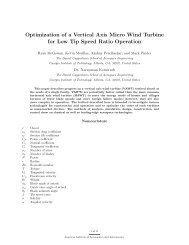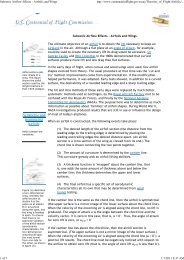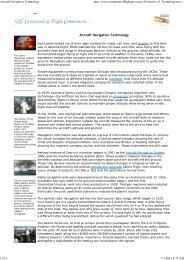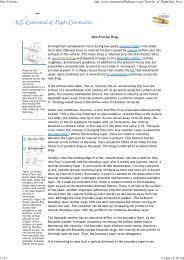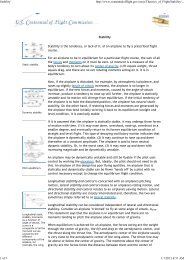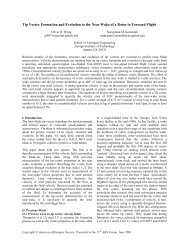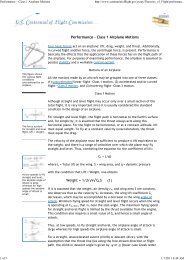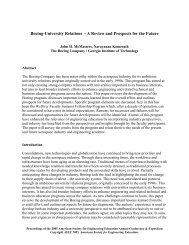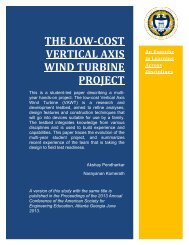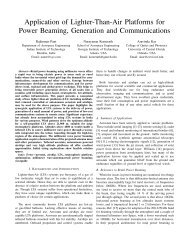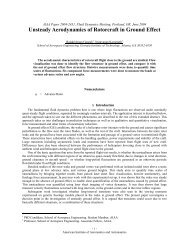p density of fluid, kg/m3 [Greek letter rho] V mean velocity of fluid, m ...
p density of fluid, kg/m3 [Greek letter rho] V mean velocity of fluid, m ...
p density of fluid, kg/m3 [Greek letter rho] V mean velocity of fluid, m ...
You also want an ePaper? Increase the reach of your titles
YUMPU automatically turns print PDFs into web optimized ePapers that Google loves.
Real_Fluid_Flowhttp://www.centennial<strong>of</strong>flight.gov/essay/Theories_<strong>of</strong>_Flight/Real_Flui...2 <strong>of</strong> 3 1/1/2011 8:33 AMd characteristic length, mµ coefficient <strong>of</strong> viscosity, <strong>kg</strong>/m-secFor this setup, Reynolds found, by using water, that below R = 2,100, the flow inthe pipe was laminar as evidenced by the distinct colored filament. This valuewas true regardless <strong>of</strong> the varying combinations <strong>of</strong> values <strong>of</strong> p, V, d, or µ. Atransition between laminar and turbulent flow occurred for Reynolds numbersbetween 2,100 and 40,000 depending upon how smooth the tube junction wasand how carefully the flow entered the tube. Above R = 40,000, the flow wasalways turbulent, as evidenced by the colored <strong>fluid</strong> filament breaking upquickly. The fact that the transition Reynolds number (between 2,100 and40,000) was variable indicates the effect that induced turbulence has on theflow.The numerical values given for the transition are for this particular experimentsince the characteristic length chosen, d, is the diameter <strong>of</strong> the pipe. For anairfoil, d would be the distance between the leading and trailing edge called thechord length. Additionally, water was used in the Reynolds experiment whereasair flows about an airfoil. Thus, the transition number between laminar andturbulent flow would be far different for the case <strong>of</strong> an airfoil. Typically, airfoilsoperate at Reynolds numbers <strong>of</strong> several million. The general trend, however, isevident. For a particular body, low Reynolds number flows are laminar and highReynolds number flows are mostly turbulent.The Reynolds number may be viewed another way:The viscous forces arise because <strong>of</strong> the internal friction <strong>of</strong> the <strong>fluid</strong>. The inertiaforces represent the <strong>fluid</strong>'s natural resistance to acceleration. In a low Reynoldsnumber flow, the inertia forces are negligible compared with the viscous forces,whereas in a high Reynolds number flow, the viscous forces are small relative tothe inertia forces. An example <strong>of</strong> a low Reynolds number flow (called Stoke'sflow) is a small steel ball dropped into a container <strong>of</strong> heavy silicon oil. The ballfalls slowly through the liquid; viscous forces are large. Dust particles settlingthrough the air are another case <strong>of</strong> a low Reynolds number flow. These flows arelaminar. In a high Reynolds number flow, such as typically experienced in theflight <strong>of</strong> aircraft, both laminar and turbulent flows are present.Surface roughness also affects a body immersed in a flow field. Surfaceroughness causes the flow near the body to go from laminar to turbulent. As thesurface roughness increases, the first occurrence <strong>of</strong> turbulent flow will moveagainst the direction <strong>of</strong> the flow along the airfoil. The Reynolds number andsurface roughness are not independent <strong>of</strong> each other and both contribute to thedetermination <strong>of</strong> the laminar to turbulent transition. A very low Reynoldsnumber flow will be laminar even on a rough surface and a very high Reynoldsnumber flow will be turbulent even though the surface <strong>of</strong> a body is highlypolished.Another important factor in the transition from laminar to turbulent flow is thepressure gradient in the flow field. If the static pressure increases withdownstream distance, disturbances in a laminar flow will be amplified andturbulent flow will result. If the static pressure decreases as distance in thedirection <strong>of</strong> the airflow increases, disturbances in a laminar flow will damp out(or decrease) and the flow will tend to remain laminar. Over an airfoil, thestatic pressure decreases up to the point <strong>of</strong> maximum thickness. A laminar flow


![p density of fluid, kg/m3 [Greek letter rho] V mean velocity of fluid, m ...](https://img.yumpu.com/50595898/2/500x640/p-density-of-fluid-kg-m3-greek-letter-rho-v-mean-velocity-of-fluid-m-.jpg)
